The mid-size SUV segment has become increasingly competitive, with the Ford Kuga and Hyundai Tucson standing out as two notable contenders. As drivers seek performance, comfort, and technology, these models offer a wealth of options that warrant a closer comparison. Let’s dive into the finer points of these two SUVs and see how they stack up against each other.
Ford Kuga vs Hyundai Tucson – Which one offers the better deal?
Everyday use, family trips or long-distance drives – here’s where the differences show.
Discover whether Ford Kuga or Hyundai Tucson fits your lifestyle better.
Pricing and Models
The Ford Kuga boasts a price range starting from €39,950 to €52,200 across various configurations. It offers a selection of powertrains, including petrol, full hybrid, and plug-in hybrid options, making it versatile for different driving preferences.
In contrast, the Hyundai Tucson presents a slightly more diverse pricing spectrum, from €34,990 to €54,050. Comparable to the Kuga, the Tucson also provides a variety of engines, including diesel MHEV, petrol MHEV, full hybrid, and plug-in hybrid models. Both cars offer solid value, but the Tucson holds the edge with a lower entry price.
Dimensions and Design
The Ford Kuga measures between 4,604 mm and 4,645 mm in length, with a width of 1,882 mm and a height ranging from 1,675 mm to 1,681 mm. In terms of trunk capacity, it offers a respectable 412 liters, catering well to families or adventurers needing extra storage.
On the other hand, the Hyundai Tucson is marginally longer at 4,510 mm to 4,520 mm, with a width of 1,865 mm and a height of 1,650 mm. The Tucson’s trunk capacity is remarkable, providing between 546 and 620 liters, making it ideal for hauling larger items effortlessly.
Powertrains and Performance
The Kuga is powered by a range of engines, including a robust 243 HP variant and a hybrid option with a fuel consumption as low as 0.9 L/100 km. This makes it particularly appealing for those conscious of fuel efficiency. Additionally, it can accelerate from 0-100 km/h in as little as 7.3 seconds.
Conversely, the Tucson also offers impressive power with options that boast up to 252 HP. Its best-performing variant accelerates from 0-100 km/h in just 7.9 seconds, with a fuel consumption that can dip to an impressive 1.0 L/100 km for its hybrid configurations. The Kuga wins in terms of pure hybrid range with an electric-only range of 69 km, while the Tucson slightly lags with 65 km to 70 km.
Driving Experience
In terms of driving dynamics, both vehicles offer all-wheel drive options, but the Kuga's CTV and manual gearbox options provide a nuanced approach for driving enthusiasts. The Kuga’s top speed can reach 200 km/h, whereas the Tucson caps at 194 km/h, indicating a slight performance edge for the Ford.
However, the Tucson’s diesel and MHEV options grant it a preferable torque rating of up to 367 Nm, delivering a more vigorous pull than the Kuga’s 240 Nm. This makes the Tucson a more compelling option for those who prioritize towing or off-road capabilities.
Safety and Technology Innovations
Both SUVs are equipped with cutting-edge safety and technology features. The Ford Kuga includes advanced driver-assistance systems like adaptive cruise control and blind-spot monitoring, ensuring a safe journey.
The Hyundai Tucson matches these offerings with its suite of safety technologies, including smart cruise control, lane-keeping assist, and an impressive set of collision avoidance systems. In terms of infotainment, both models offer modern touchscreen interfaces compatible with Apple CarPlay and Android Auto, creating a seamless connection to your smartphone.
Conclusion
In the battle of the Ford Kuga versus the Hyundai Tucson, both vehicles bring unique strengths to the table. The Kuga excels with its hybrid technology and performance, while the Tucson showcases versatility with its engine options and spacious interior.
Ultimately, the choice will depend on individual preferences for performance, comfort, and design. Whichever model you choose, both the Kuga and Tucson promise to deliver a compelling driving experience in the competitive SUV market.
Here’s where it gets real: The technical differences in detail
Costs and Efficiency:
Looking at overall running costs, both models reveal some interesting differences in everyday economy.
Hyundai Tucson has a a bit advantage in terms of price – it starts at 30600 £, while the Ford Kuga costs 34200 £. That’s a price difference of around 3608 £.
Fuel consumption also shows a difference: Hyundai Tucson manages with 1 L and is therefore convincingly more efficient than the Ford Kuga with 2.80 L. The difference is about 1.80 L per 100 km.
As for range, the Hyundai Tucson performs hardly perceptible better – achieving up to 70 km, about 2 km more than the Ford Kuga.
Engine and Performance:
Under the bonnet, it becomes clear which model is tuned for sportiness and which one takes the lead when you hit the accelerator.
When it comes to engine power, the Hyundai Tucson has a slight edge – offering 252 HP compared to 243 HP. That’s roughly 9 HP more horsepower.
In acceleration from 0 to 100 km/h, the Ford Kuga is barely noticeable quicker – completing the sprint in 7.30 s, while the Hyundai Tucson takes 7.90 s. That’s about 0.60 s faster.
In terms of top speed, the Hyundai Tucson performs hardly perceptible better – reaching 204 km/h, while the Ford Kuga tops out at 200 km/h. The difference is around 4 km/h.
There’s also a difference in torque: Hyundai Tucson pulls evident stronger with 379 Nm compared to 240 Nm. That’s about 139 Nm difference.
Space and Everyday Use:
Whether family car or daily driver – which one offers more room, flexibility and comfort?
Both vehicles offer seating for 5 people.
In curb weight, Ford Kuga is minimal lighter – 1526 kg compared to 1542 kg. The difference is around 16 kg.
In terms of boot space, the Hyundai Tucson offers distinct more room – 620 L compared to 412 L. That’s a difference of about 208 L.
In maximum load capacity, the Hyundai Tucson performs a bit better – up to 1799 L, which is about 265 L more than the Ford Kuga.
When it comes to payload, Ford Kuga barely noticeable takes the win – 550 kg compared to 545 kg. That’s a difference of about 5 kg.
Who wins the race?
The Hyundai Tucson proves to be wins the duel decisively and therefore becomes our DriveDuel Champion!
Hyundai Tucson is the better all-rounder in this comparison.
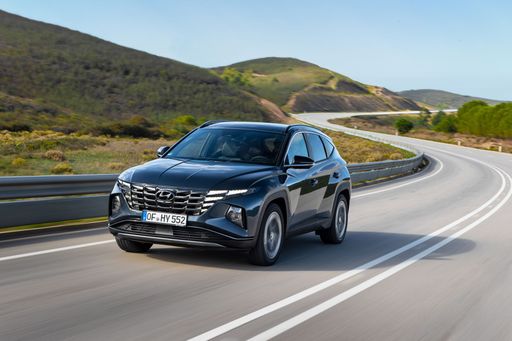 @ Hyundai Motor Company
@ Hyundai Motor Company
Hyundai Tucson
Ford Kuga
The Kuga is Ford’s adaptable family SUV that blends usable space with a surprisingly lively driving character, making daily commutes and weekend escapes equally enjoyable. With smart interior packaging, an easy-to-use infotainment setup and composed road manners, it’s a sensible choice for buyers who want a bit of fun without the fuss.
details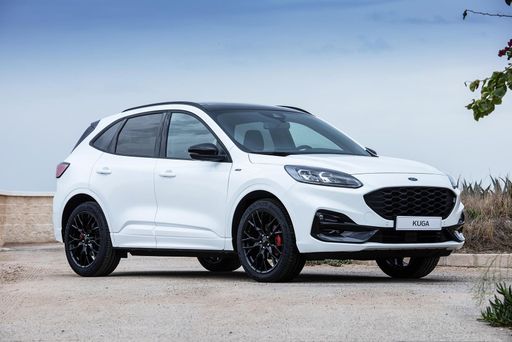 @ Ford Motor Company / Ford Media Center
@ Ford Motor Company / Ford Media Center
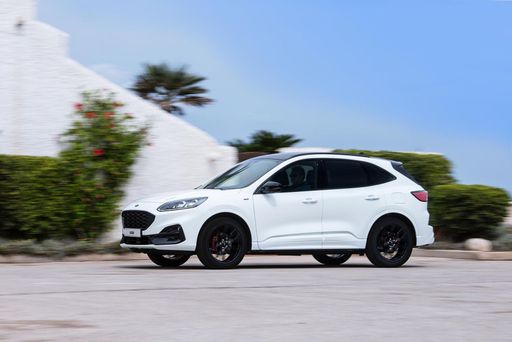 @ Ford Motor Company / Ford Media Center
@ Ford Motor Company / Ford Media Center
 @ Ford Motor Company / Ford Media Center
@ Ford Motor Company / Ford Media Center
Hyundai Tucson
Hyundai Tucson marries bold, sculpted looks with a clever, roomy cabin that feels smarter than its price tag suggests. It's composed on the road, easy to live with day-to-day, and a sensible choice for buyers who want SUV style without the showroom theatrics.
details @ Hyundai Motor Company
@ Hyundai Motor Company
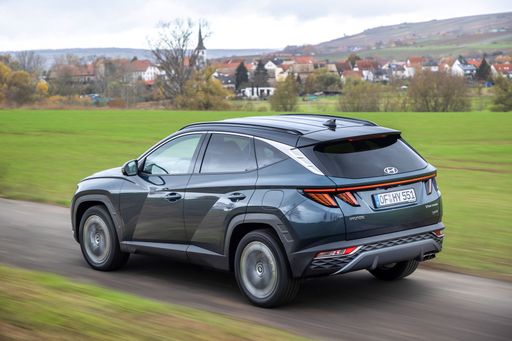 @ Hyundai Motor Company
@ Hyundai Motor Company
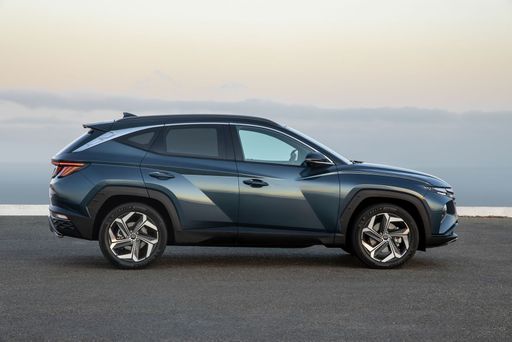 @ Hyundai Motor Company
@ Hyundai Motor Company
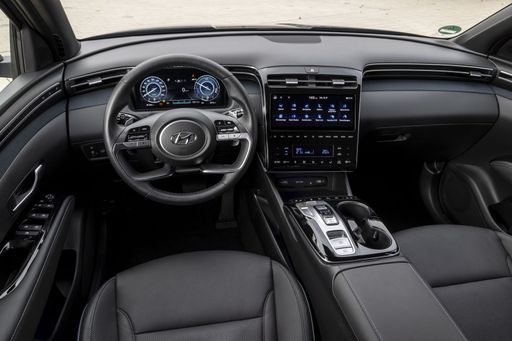 @ Hyundai Motor Company
@ Hyundai Motor Company
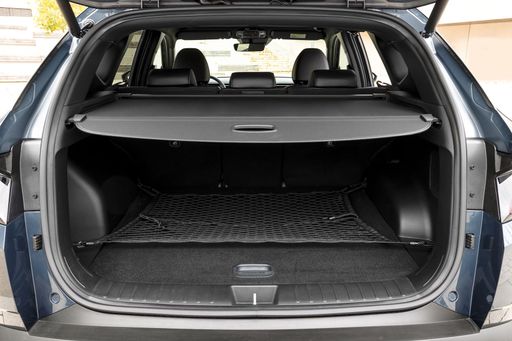 @ Hyundai Motor Company
@ Hyundai Motor Company
 @ Ford Motor Company / Ford Media Center
@ Ford Motor Company / Ford Media Center
|
 @ Hyundai Motor Company
@ Hyundai Motor Company
|
|
|
|
Costs and Consumption |
|
|---|---|
|
Price
34200 - 46300 £
|
Price
30600 - 46300 £
|
|
Consumption L/100km
2.8 - 6.8 L
|
Consumption L/100km
1 - 7.6 L
|
|
Consumption kWh/100km
-
|
Consumption kWh/100km
-
|
|
Electric Range
68 km
|
Electric Range
64 - 70 km
|
|
Battery Capacity
1.1 - 14.4 kWh
|
Battery Capacity
-
|
|
co2
55 - 154 g/km
|
co2
22 - 172 g/km
|
|
Fuel tank capacity
42 - 54 L
|
Fuel tank capacity
42 - 54 L
|
Dimensions and Body |
|
|---|---|
|
Body Type
SUV
|
Body Type
SUV
|
|
Seats
5
|
Seats
5
|
|
Doors
5
|
Doors
5
|
|
Curb weight
1526 - 1859 kg
|
Curb weight
1542 - 1889 kg
|
|
Trunk capacity
412 L
|
Trunk capacity
546 - 620 L
|
|
Length
4604 - 4645 mm
|
Length
4510 - 4535 mm
|
|
Width
1882 mm
|
Width
1865 mm
|
|
Height
1673 - 1681 mm
|
Height
1650 mm
|
|
Max trunk capacity
1534 L
|
Max trunk capacity
1721 - 1799 L
|
|
Payload
541 - 550 kg
|
Payload
523 - 545 kg
|
Engine and Performance |
|
|---|---|
|
Engine Type
Petrol, Full Hybrid, Plugin Hybrid
|
Engine Type
Diesel MHEV, Plugin Hybrid, Petrol, Full Hybrid
|
|
Transmission
Manuel, Automatic
|
Transmission
Automatic, Manuel
|
|
Transmission Detail
Manual Gearbox, CVT, Automatic Gearbox
|
Transmission Detail
Dual-Clutch Automatic, Automatic Gearbox, Manual Gearbox
|
|
Drive Type
Front-Wheel Drive, All-Wheel Drive
|
Drive Type
Front-Wheel Drive, All-Wheel Drive
|
|
Power HP
150 - 243 HP
|
Power HP
136 - 252 HP
|
|
Acceleration 0-100km/h
7.3 - 9.9 s
|
Acceleration 0-100km/h
7.9 - 11.6 s
|
|
Max Speed
195 - 200 km/h
|
Max Speed
180 - 204 km/h
|
|
Torque
240 Nm
|
Torque
250 - 379 Nm
|
|
Number of Cylinders
3 - 4
|
Number of Cylinders
4
|
|
Power kW
111 - 178 kW
|
Power kW
100 - 185 kW
|
|
Engine capacity
1496 - 2488 cm3
|
Engine capacity
1598 cm3
|
General |
|
|---|---|
|
Model Year
2025
|
Model Year
2024 - 2025
|
|
CO2 Efficiency Class
E, D, B
|
CO2 Efficiency Class
E, B, F, D
|
|
Brand
Ford
|
Brand
Hyundai
|
What drivetrain options does the Ford Kuga have?
The Ford Kuga is available as Front-Wheel Drive or All-Wheel Drive.
The prices and data displayed are estimates based on German list prices and may vary by country. This information is not legally binding.
